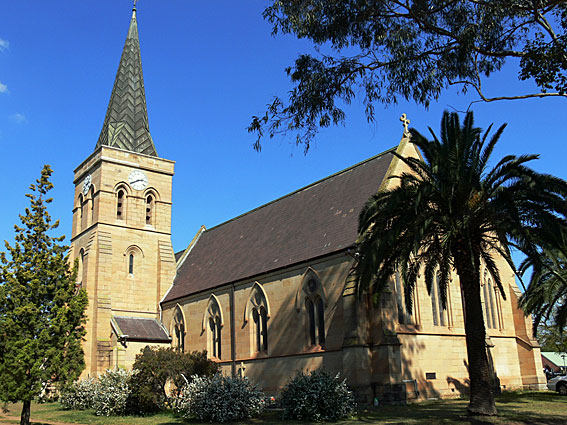
St Albans's Anglican Church, Muswellbrook:
exterior from the north-west
[photograph by John Maidment (2 October 2015)]

St Albans's Anglican Church, Muswellbrook:
exterior from the north-west
[photograph by John Maidment (2 October 2015)]
Historical and Technical Documentation by Kelvin Hastie
© OHTA, 2015 (last updated September 2015)
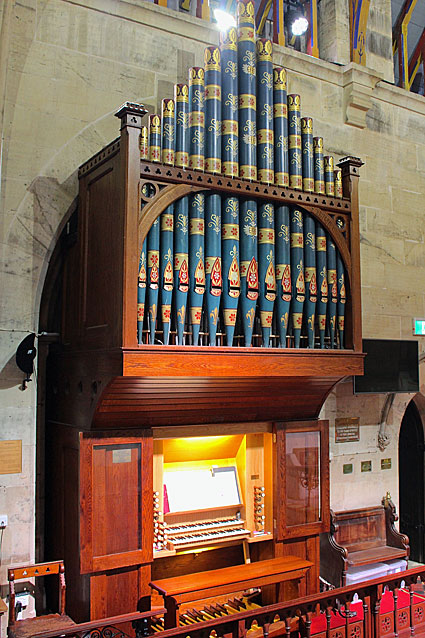
St Albans's Anglican Church, Muswellbrook: organ
[photograph by Trevor Bunning (2 October 2015)]
This church is the only building designed for Australia by the noted English architect Sir George Gilbert Scott (1811-1878). Built 1864-1869, it is constructed in stone with a copper-clad broach spire to the north. Construction was supervised by John Horbury Hunt and in the 1880s the wooden bell tower and the fence were added to his designs. In 1914 the clock and bells were provided to the tower in memory of Archdeacon White.
Writing about the church and organ in 2005, the late Geoff Bock (editor of The Sydney Organ Journal and OHTA member at the time) stated that 'St Alban's is a handsome building with some fine stained glass. Although not large, the church has a quite lively acoustic, somewhat unusual in a heavy stone structure of only modest proportions. St Alban's is also unusual in that the parish has endowed an annual organ scholarship in the memory of Fr Geoffrey, later Bishop Parker, who was the twelfth rector (appointed in 1970) and who greatly valued the use of music in the liturgy and encouraged his organists to strive for the highest standards. The scholarship is in the form of a competition carrying a cash prize of $1,000, a generous amount for a regional parish.1
The organ was built in 1868 by J.W. Walker of London, as job number 886. The firm's ledger book gives the specification of this single-manual instrument as containing a Bourdon Bass 16 (playable in the lowest octave of the manual only), an Open Diapason 8, Stopped Diapason Bass/Clarabella Treble 8, Dulciana 8, Principal 4, Fifteenth 2 and one vacant slider. The pedals were permanently coupled to the manuals. 2
The instrument was documented in February 1985 by John Stiller, who also provided some notes on the later history and significance of the organ. He noted that the organ had been enlarged to two manuals, with stylistic evidence pointing to Charles Richardson, of Sydney, for this. With the exception of the 12 pipes of the Bourdon Bass, all Walker pipework survived the extensive Richardson rebuild. In 1894 a Gamba and Flute were added as the gift of Mrs Wilson, sister-in-law of the rector at the time.3
In 1976 the pedal was electrified by Ian D. Brown and some tonal modifications were made: Bock records that the Swell Piccolo 2 dates from this time.4 Differences between the specification noted by Graeme Rushworth in 1970 and the Stiller documentation of 1985 reveal other changes: basically the Walker Stopped Diapason Bass & Clarabella Treble had served a period of time at higher pitch, while the Richardson Harmonic Flute 8 had been transposed to 4ft pitch. A Nazard 2-2/3 had been added to the Great, while the Richardson Swell Voix Celestes had been displaced by the aforementioned 2ft stop, its pipes being stamped "BF" for Block Flöte. John Stiller also noted that since the Richardson enlargement, a tremulant had been added, the hand-blowing apparatus had been removed and that tuning slides had been added to most internal open metal pipes.5
The specification in 1985 was as follows:
| GREAT Open Diapason Stop Diapason Dulciana Principal Harmonic Flute Nazard Fifteenth SWELL Violin Diapason Lieblich Gedact Stopd. Bass Gamba Voix Celestes Gemshorn PEDAL Grand Bourdon COUPLERS Swell to Great Swell to Pedal Great to Pedal |
8 8 8 4 8 2-2/3 2 8 8 8 8 8 4 16 |
+ = (TC ) ~ (TC) (C-B) (TC) * |
Compass 56/30 ^
Mechanical action to manuals
Electric action to pedals
+ Sounding at 4' pitch
= An addition using stopped wood and open metal pipes
~ Pipes stamped "KER" for Keraulophon
* Displaced by Block Flöte 2'
^ Extended from an earlier 29-note compass6
In 2005 Ian D. Brown & Associates built what is essentially a new organ for the church. Geoff Bock records the process as follows:
The instrument always had problems because of its very cramped position under a low arch which made access to some pipes and action parts impossible. Over the years water damage had added to the problems and running repairs were never able to fully compensate for the constant difficulties and the organ eventually became unserviceable.
St Alban's now has a new organ - not a rebuild, restoration or refurbishment, since … it uses only the extant original pipework. The instrument . . . attempts to create what J. W. Walker might have conceived if a new organ of 17 stops had been ordered from his firm in 1868. The former cramped location problem with its attendant difficulties has been overcome by placing the new casework further out at ground level and three feet further forward overhead, allowing the Great organ to speak directly into the space and bringing the Swell box right to the front of the arch. . . . The castellated moulding and trefoils of the topside rail are replicas of the original front rail. The large beams supporting the overhang carry the same motif as the end brackets of the original façade. Hand carved work on the music desk, key cheeks and stop knobs have been copied from the Walker style with all of the new casework timber in oak to match the original. Jennifer Brown has refurbished the original display pipe stencilling and its warm rich tones complement the stained glass above and in front of the case.7
Ian Brown reported on the new organ in his Newsletters of December 2004 and June 2005. This states that the new console is modelled on the 1866 Walker organ at St John's Cooks Hill (Newcastle) and the larger Walker instrument at St Stephen's Richmond, Victoria. The various rationales for supplying a parallel pedalboard, hitch-down swell pedal, pneumatic action for the façade pipes and newly-constructed suspended mechanical key action are all explained, together with constructional details of the case and use of oak.8
The specification is:
| GREAT Open Diapason Wald Flute Dulciana Principal Flute Harmonic Fifteenth Mixture II SWELL Lieblich Gedacht Keraulophon Vox Celestes Gemshorn Piccolo Cremona Trumpet PEDAL Bourdon Principal Cremona COUPLERS Swell to Great Swell to Pedal Great to Pedal Tremulant |
8 8 8 4 4 2 II 8 8 8 4 2 16 8 16 8 16 |
W W W W R W P R R R R B * P W/R P+ * P |
Compass 56/30
* The Cremona 16ft is actually a Swell Stop and borrowed to the pedals by mechanical transmission.
+ The lowest 15 notes of the Pedal Principal 8 are borrowed from the Great Open Diapason (façade pipes) by pneumatic action.
Mechanical action
W = J.W. Walker 1868
R = Charles Richardson 1895
B = Ian D. Brown 1976
P = prepared for 2005 [installed 2011]9
______________________________
1. Geoff Bock, 'On making the acquaintance of a new organ', Sydney Organ Journal, 36/4(Spring 2005): pp.51-2. See also: George Gilbert Scott 1811-1878: an Architect and His Influence, edited by P.S. Barnwell, Geoffrey Tyack and William White. Donington, UK: Shaun Tyas, 2014, pp.74-75 and Peter Reynolds, Lesley Muir, Joy Hughes, John Horbury Hunt: Radical Architect 1838-1904. Sydney: Historic Houses Trust of NSW, 2002, p.42.
2. John Stiller, St Alban's Anglican Church, Muswellbrook NSW - Documentation of Pipe Organ built by J.W. Walker, 1868. Organ Historical Trust of Australia, 14 February 1985, p.2.
3. Ibid.
4. Bock, op.cit., p.52.
5. Stiller, op.cit., p.2.
6. Ibid., p.4.
7. Bock, op.cit., p.51.
8. Ian D. Brown & Associates. "December Newsletter 2004 ", 3 and "June Newsletter 2005", 3. Unpublished pamphlets, supplied by Mark Quarmby, June 2015.
9. Bock, op.cit. 52.
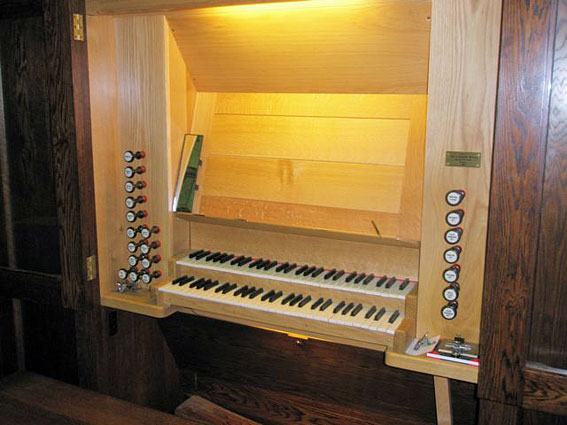
St Albans's Anglican Church, Muswellbrook: console
[photograph by David Evans (July 2008)]
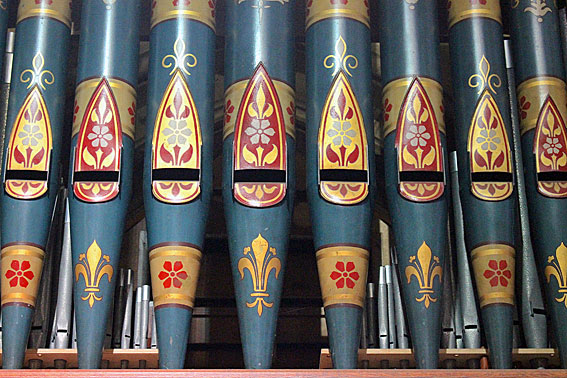
St Albans's Anglican Church, Muswellbrook: detail of pipe stencilling
[photograph by Trevor Bunning (2 October 2015)]
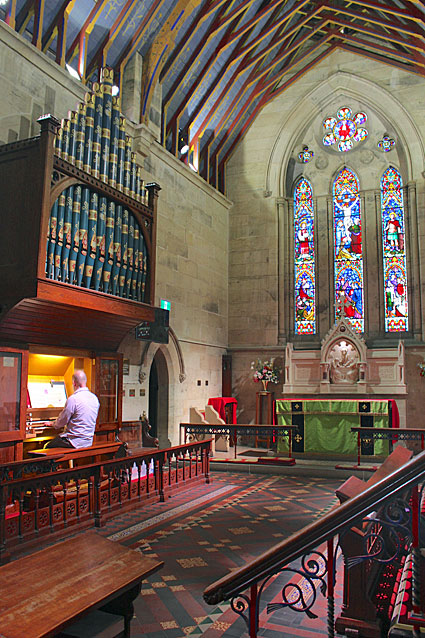
St Albans's Anglican Church, Muswellbrook: organ and chancel – Jeremy Fletcher at the console
[photograph by Trevor Bunning (2 October 2015)]
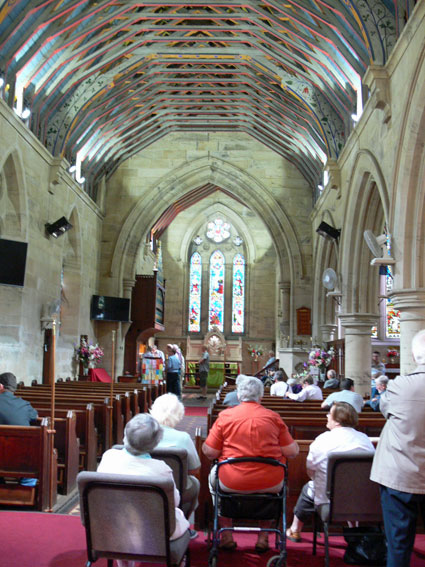
St Albans's Anglican Church, Muswellbrook: interior from the west
[photograph by John Maidment (2 October 2015)]
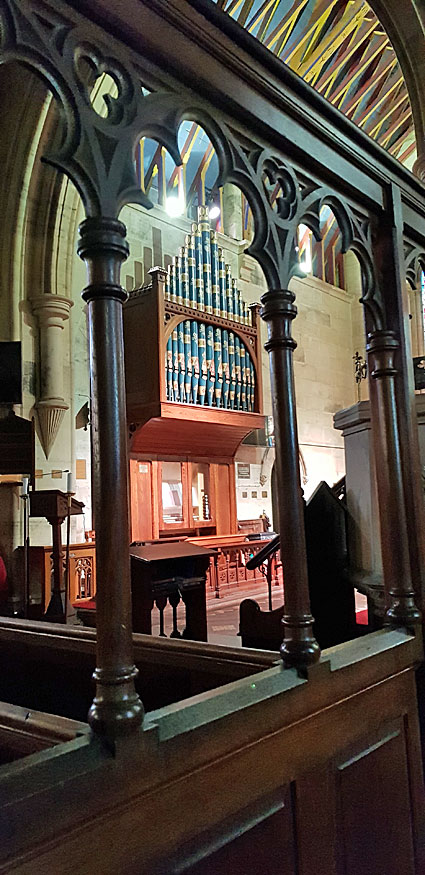
St Albans's Anglican Church, Muswellbrook: organ
[photograph by Ian Brown (March 2021)]
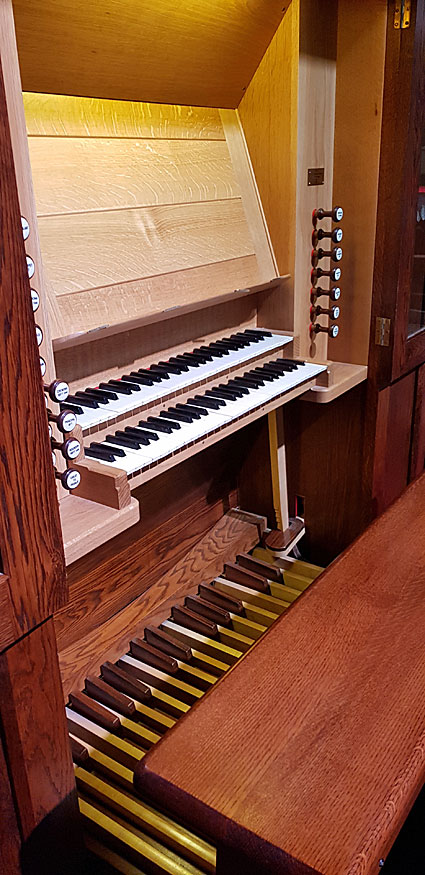
St Albans's Anglican Church, Muswellbrook: organ console
[photograph by Ian Brown (March 2021)]
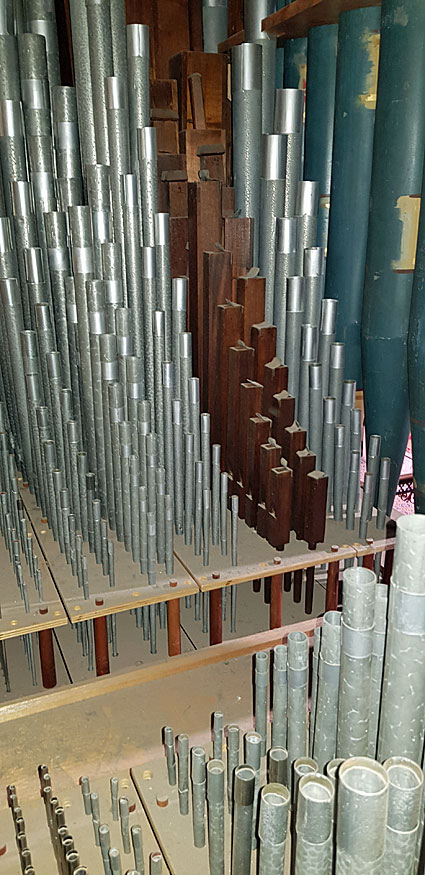
St Albans's Anglican Church, Muswellbrook: pipework
[photograph by Ian Brown (March 2021)]
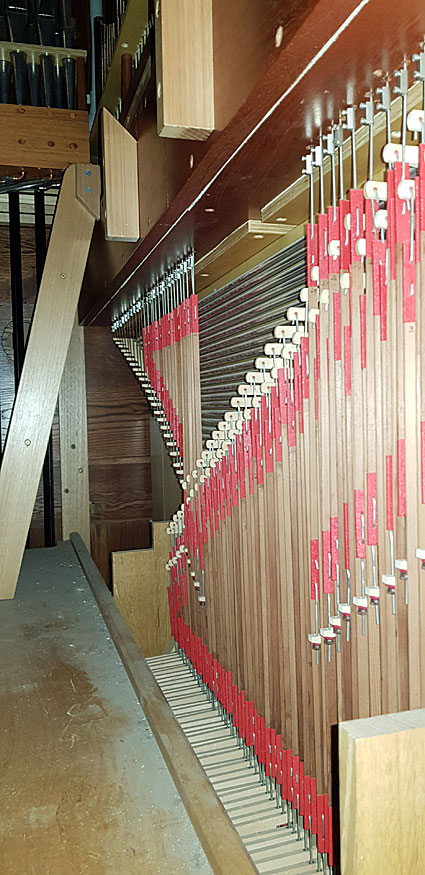
St Albans's Anglican Church, Muswellbrook: action
[photograph by Ian Brown (March 2021)]
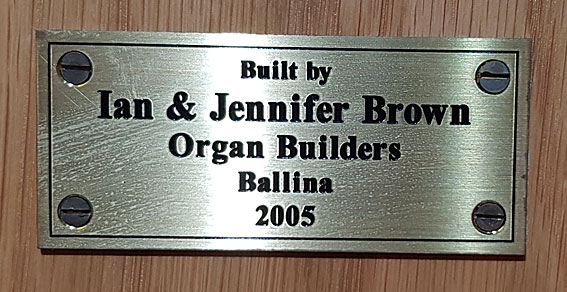

St Albans's Anglican Church, Muswellbrook: organ nameplates
[photograph by Ian Brown (March 2021)]

St Albans's Anglican Church, Muswellbrook: organ case
[photograph by Ian Brown (March 2021)]